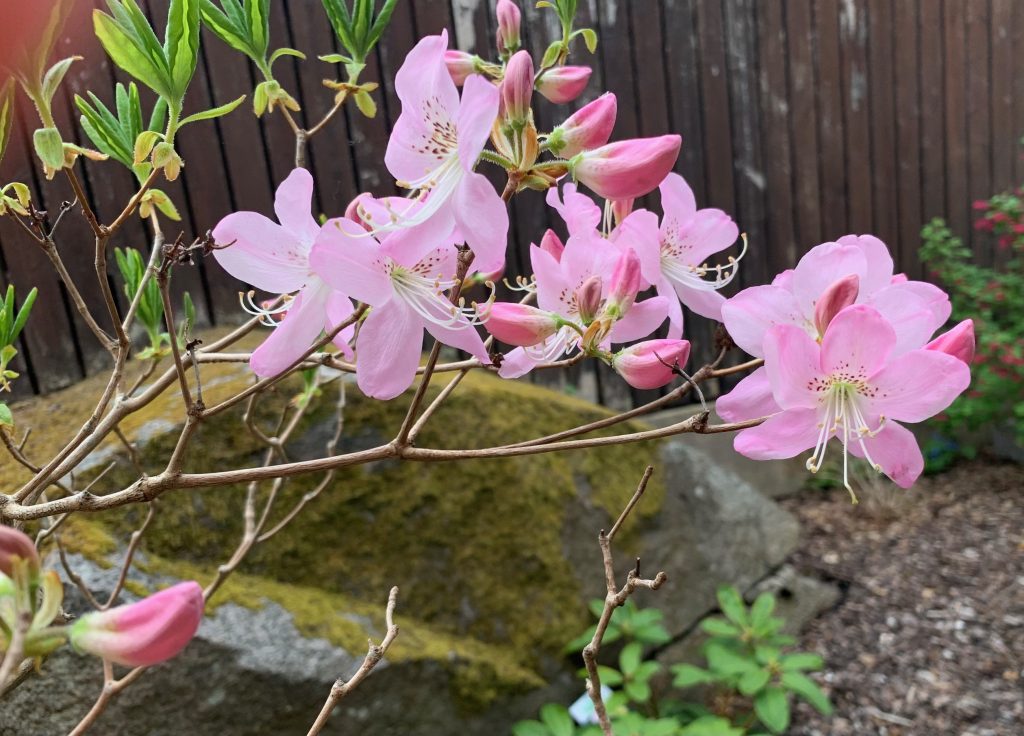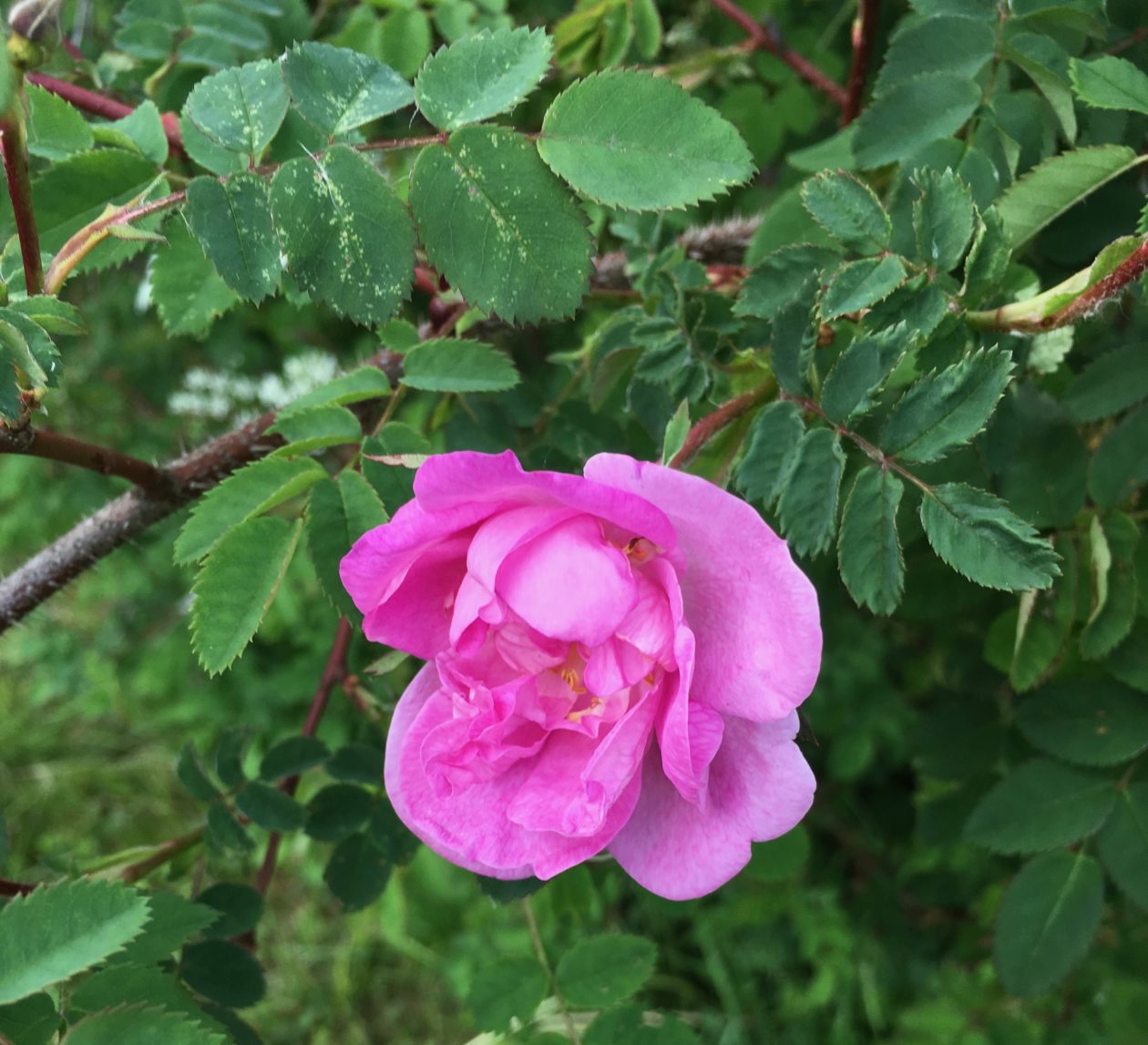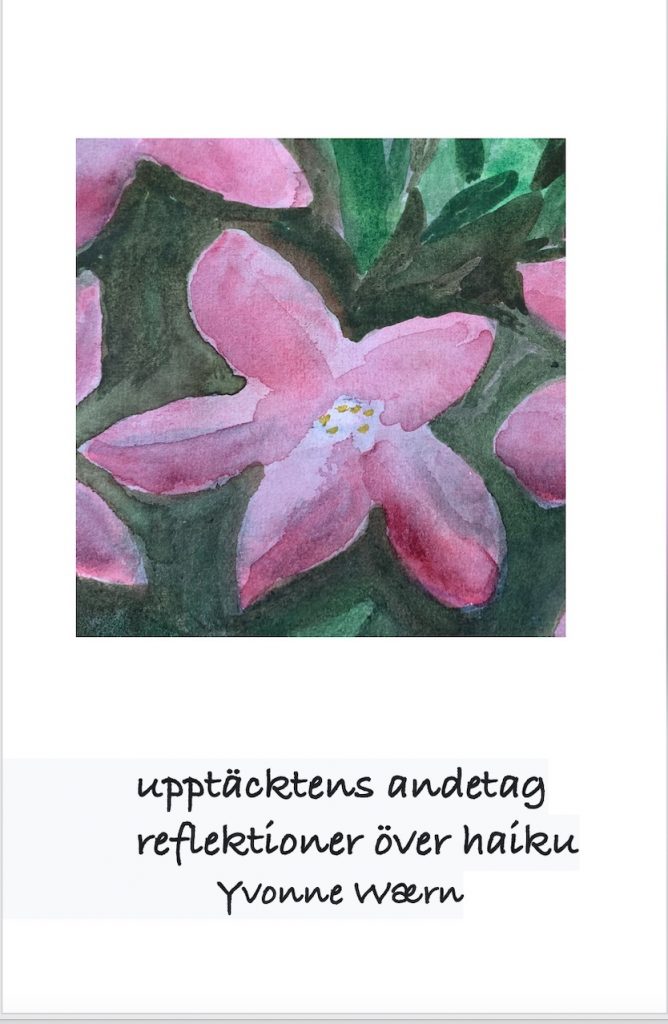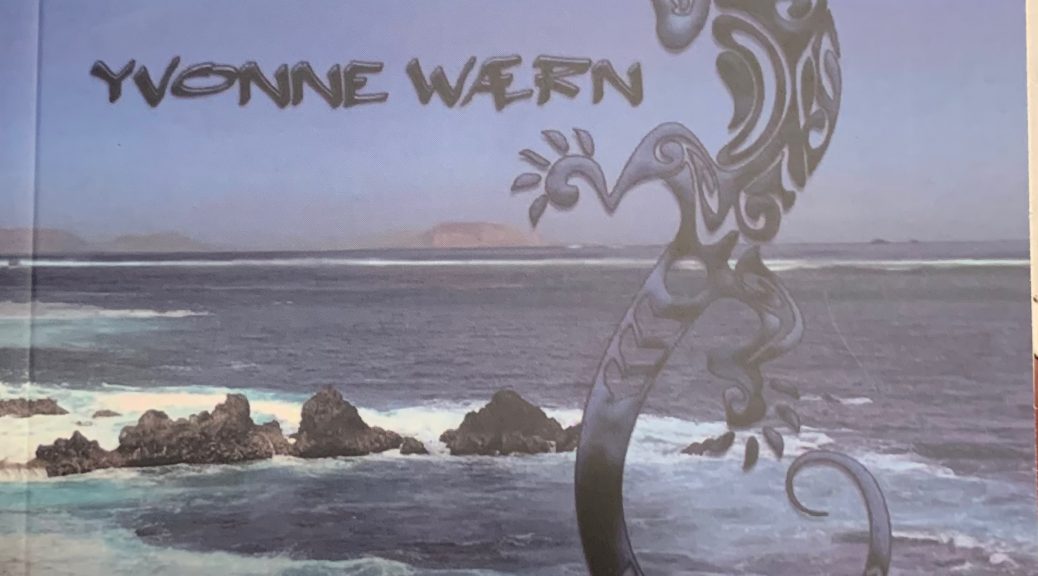THE FIRST SIX MONTHS OF LEARNING
With comments
YVONNE WÆRN
ISBN 9789198652833
Table of contents
Preface
Phase 1. 5-7-5
Phase 2. Getting into haibun
Phase 3. Not 5-7-5
Phase 4. An important sidetrack
Phase 5. Phrase and fragment
Phase 6. Morning fragrance. A haibun
Phase 6. Refining a haiku
Phase 7. Various forms of haiku
A memory
Second thoughts
Sailing memories. A haibun
On #Prompts
From idea to poem
Writing after memory
Getting inspired by others
Using old memories
THANKS
Preface
Curiosity is the mother of much joy and irritation.
I had heard about haiku.I joined some haiku groups on Facebook in order to learn something about haiku writing.
Here I want to share some of the lessons I have received. I may not have understood everything. Everybody says that you can continue learning haiku during your whole life.
Therefore, I am grateful if you have any comments.
You are welcome to email me:
yvonne.waern@gmail.com
Phase 1 Five seven five
First, I thought that haiku were short poems, to be written on three lines., with five syllables on the first, seven on the second and five on the third.
I also had understood that a note about the season should be made.

when my flower smiles
I smile, too, in early May
later tears will fall.
Comment:
No anthropomorphism in haiku!
So I learned some
(to be unlearned later)
In next attempt, I was still stuck with the idea of 5-7-5
fruit trees are making
tasty flower cakes in May
no guests are coming
No comments
Was this OK?
Phase 2.
Getting into haibun
#Olive
Background:
I have several times witnessed olive farmers in Spain during their harvest of olives. They place a piece of cloth under the tree, climb up the tree and shake. On the ground lies their harvest, to be sorted out from the leaves and small twigs.
1.
untidy business
leaves and fruits on the ground
olive harvest
2.
shaken twigs scatter
fruits on farmers’ carpet
for a Golden stream
Comment:
A haibun is a short story then a haiku. we don’t usually use images though.
(I had included an image )
Another haibun
”Morning fragrance”
I sat at the veranda, watching the bird chicks play on the roof.
One fell and I was on my way to get up to rescue it, when he flapped his wings and disappeared into the wet leaves of a cherry tree.
flapping sound
flowers catch sun rays
after morning rain
It started raining again, fine drops fell on the flowers.
Then I noticed the exquisite smell.
fragrance arrives
nose shivers
A bumble bee buzzed above the flowers close to me, but stopped at my sight and backed into the air.
bumble bee searching
shocked at the sight
behind the flowers
No reactions. It was, after all, summer.
Much later, one of my nicest haiku friends told me that this was again an anthropomorphism.
Now, much later, I see that I should write in current time, that is ”sit” insteadof ”sat”, for instance.
Phase 3.
Not 5-7-5
I read that the 5-7-5 syllables may be a misunderstanding. In English a syllable is different from the Japanese ”mora”. Thus, I left the 5-7-5 pattern.
#decorum
the grazing robot
has stopped working
dandelions
Comment:
The grazing robot is a funny idea.
Phase 4. No aphorisms!
Haiku are so short that I easily fell into a habit of writing aphorisms. However, I was soon told that this isn’t right. Here some of my critisized attempts:
Garden snail
home is everywhere
when it’s on your back
Comment:
It is a nice shahai (haiku + photo). However, if you take the haiku alone, it is more like a saying than a haiku. You may want to make it more traditional with something like:
Home on your back
Heavy and everywhere
Slow globetrotter
Another example,
now on the theme of ”shadow”. I was inspired by a photo that I had taken:
Nobody
escapes
his shadow
It is easily seen that this isn’t a haiku. It might qualify as a one_liner, a monostich or a monoku. However, it has not got the preferred form of a haiku, no fragment/phrase structure (to be presented in phase 5).
This was pointed out by some commentator, who also said that this was more of an aphorism than a haiku. And haiku are not about aphorisms.
An important sidetrack
In early summer I am usually obsessed with the sun and the light. Thus, the prompts concerned with sun fitted me very well.
#Sunshine
After eight months of indoor enclosure sunshine appears.
dropping mobile
sorry, I have to leave –
the door opens
#Sunshine
six hours of travel
in a sardine coffiin
– sunshine!
#Sunshine
on my tombstone
just one word:
LIGHT
#Sunshine
a spoonful of
summer sun enough for a
winter day
Much later I understood that this maybe another aphorism
Phase 5.
Phrase and fragment
In next phase I learned that the three lines of a haiku should be constructed as follows:
Two lines that are called ”a phrase”, describing one observation.
A third line called ”a fragment”, that should contain another observation, linked to the first phrase by either an association, a contrast or a comparison.
I take the following as my example. It is mocking haiku, I think, but it is very typical:
Haiku are simple
but sometimes they don’t make sense
REFRIGERATOR
(quote usually attributed to Roger Nelson)
Here are some examples of my attempts:
October afternoon
waiting for coffee
the cozy armchair
apples in the grass
small holes in each skin
birds fly up
a cluttered mind
that’s where you find
the unexpected
jumping up in air
ending in free fall …
from the bed
the kicked ball unfurls –
children run away
with the cat
Phase 6
Refining a haiku – an example
A haiku is short enough for the poet to reflect over every single word. Sometimes experienced haijins (English for haiku poets) react to my attempts. I am going to show here what happened to a haiku that I published in the group ”Haiku Nuggets”.
It started with me reacting to a ”prompt” that was ”elephant”. I was going to do something different, let the elephant be fictional in a book and then step out of the book.
The first version was:
The elephant
in the book took just a step
my favourite doll!
The reaction from a reader was that the first two lines were good. So I should do something about the last line.
I had thought it could be a bit ambiguous: 1) the elephant stepped on my favorite doll
2) the elephant was my favorite doll.
Another reader had another suggestion:
the elephant
took just one step
from the book.
Well – it was not what I had in mind, and besides, it was just one idea and I wanted two thoughts.
I suggested a slightly different ending: 1) the elephant got a banana, 2) a fly flew its way, 3) the elephant disappeared. The commentator thought it would be good with the third: the elephant disappeared.Meanwhile still another reader came with another suggestion:
fairy tale
the elephant takes
a graceful step
which I didn’t like at all:
”No! That tells too much! With the fairy tale! A little mystery is better, as I see it. I chose ”in the book” of some reason!”
So I suggested the following:
the elephant
in the book takes just one step –
disappears
To which the commentator responds: ”the idea of Karumi”
And I of course have to ask: ”What is Karumi?”
”It is ’lightness”’-
??
Then I protest against including the word ”fairy tale”, and the commentator writes:
”Let the reader for what it is worth, decide on that by allowint him/herself to participate and interpret the poem his/her way”
I answer:
”I want to have some part in the creative process by offering cues”.
and the patient commentator points out:
”don’t make them vague and hard to understand as to muddle the overall intent of the poem.”
and then he points out something I didn’t think of before:
”the last poem has 2 verbs, kind of ”loaded” and saying too much too.”
This is not enough! He continues:
does my haiku have an ”aha” moment? Which is supposed to score bigtime in an excellent haiku poem.
No, I agreed that I hadn’t thought about the ”aha” moment. I wanted my haiku to be a little ”mystical”.
Then he writes:
”take note of the award winning haiku poems, they have layers of meaning. The reader is drawn to partipate in unravelling the moments found in haiku. Different readers may see deeper meanings which may vary one from the other.”
I have to agree, and I continue until he suggests another version:
the elephant takes just one step
… for what it is worth
Good enough, but not what I had intended. So I had to ask him how he would express the idea ”away” in English. That is the phrase magicians use when they show that something they have made disappear, really isn’t there any longer.
After a couple of rounds I found an expression I could accept and the poem finally developed into this:
the elephant
in the book took just one step …
voilà!
One more example of a revision process, now with the prompt : driftwood
My haiku: (three ”stanza”)
#Driftwood
- wooden pieces
once a home
for sailors
2)
remnants of trees
once a home
for birds
3)
my heart
once a home
for you
Comment 1:
I think the first works, with the title as the first line:
driftwood–
once a home
for sailors
That works beautifully, as a starting point. The second has a nice feel. Same structure. Maybe the first line could be slightly more direct, like:
fallen tree–
once a home
for birds
Or if you wanted to imply this, but take it in a different direction:
fallen tree–
now a home
for bugs
Here, the original is implied still, but we get the continuation of the lifecycle of the tree as well. You’ve got a nice structure here, that can produce a few poems.
Find the ones you like – then move on to a new structure/idea. 🙂
Comment 2:
Thanks for posting these verses.
Basically these verses all seem to employ the same idea and structure so I am not sure they work as well as they could as a sequence. However, it is always a good idea to have as many drafts of the one haiku to begin with, then in time when you have recovered from the thrill of creating something new with words, you can look back at all the variations, do any revisions that suggest themselves, then pick the best one and discard all the others.
My favourite draft is the first –
wooden pieces
once a home
for sailors
The first line gives me a clear sensory image of timber so it’s a good way to start a haiku. Lines 2 & 3 combine to give me a statement telling me the poet’s idea – those wooden pieces were once a ship.
There are a few problems with using a statement in a haiku rather than a sensory image. One is that it can close off the poem and give it just the one possible meaning and therefore giving the reader limited scope for discovery and interpretation. The second reason is that the poem may not reward extra readings, as there may not be enough depth and resonance in the nouns.
Your nouns here are pieces, home and sailors and they seem like good, powerful nouns to use, and are probably the reason why I prefer this verse over the others.
Phase 7. Various forms of haiku
There are many forms in which short poems can be written. Most often, three lines are used, and the form short – long – short is preferred. But it is also possible to write haiku with only one line, which then is called ”monoku”, like the following:
Soon too late to leave
(made into a shahai on top of a picture):
Another form may use two lines, and it is then called a ”duostitch”.
Something like this:
Ice on the birdbath –
where are my mittens?
You can also expand the haiku with two new (long) lines, and then it is called a ”tanka”:
Going into
the same river twice
is impossible
it is said by those
who know more than I do
This is again more similar to an aphorism, so I quickly leave this topic and turn to another one.
Senryu.
It is obvious that poets want to write about their own lives, sorrows and joys. A haiku is meant to be an observation of the nature, not of us as human beings. So, whenever love or death, sorrow or joy is described, the resulting poem is called a senryu, after the Japanese poet Karai Senryu (1718-1790). Senryu are often cynical or humorous while haiku are more serious.
Many of my haiku attempts seem to be senryu rather than haiku, but all are not cynical. Here I found one with a glimpse of irony:
Thought fragments
over a flickering screen
– social media
Writing after memory
I had a period when I painted a lot. This painting is from that period, and the memory evoked is from the fish. #fish
Once I was preparing fish for dinner. My little daughter came and wept:
Please revive him!
crying little girl
refusing fish for dinner
fish should swim
Comment (proposed edit):
crying little girl
no revival
of fish for dinnerSecond thoughts
Sometimes it may feel ephemeral and irresponsible to write haiku. I am not alone in that feeling.
A contribution by one of the members of the group ”The Daily Haiku”, Stan Phillips:
#Fragments
Fragments of stardust
swirled in the chaos of time
and we write haiku
Sailing memories
A haibun
hauling sails
Sailing creates so many memorries. I have been sailing in the Stockholm archipelago for thirty years Always an island in our way or outside of the island in some way. Once a rudder broke and we had to stay three nights in an island harbour to get it fixed. My woollen sweater reminds me of those days. I had nothing else to do than knitting.
swimming keels
summer satisfaction
From lazy leeward sailing to quick and somewhat frightening tacking (at least when the children were small)
jibs are hauled up wind
rudders turning quickly
seagulls whoop
We have to bow when the boom turns. It may come very quickly.
beware!
every turn in tack
puts my life at risk
On #Prompts
I have to reflect a little about the current practise of writing to ”prompts”. Since haiku ideally is a reaction to some nature experience, prompts are in a way ”made up” experience. As long as they touch some actual experience I just go there and look, I can also take some experience from my long life and write about that. But if I have to go to Google and see what is meant by the word, it is difficult to write from any kind of experience. Recently I have struggled with words as ”gardenia” (never met such flowers in other places than in flower shops), ”typhon” (lucky enough to see them only on TV) or ”blue moon” (I have no idea of what that may be).
I could easily relate to a prompt as ”elephant” from my childhood visits to some Zoo. I can as well imagine a frog jumping into a pond by relating them to the small frogs I see jumping on my gravel path.
However, most prompts require some extra work in order to relate to something I have seen on Television, some memory or something artificial. I wonder what effect this has on haiku writing?
I put this reflection on the Facebook group: ”sharing haiku knowledge”.
And immediately got an answer from a haiku teacher:
Haiku evolved out of hokku which itself evolved out of linked poetry where each stanza was written by a different poet. This linked poetry form is called renga and is based, crudely speaking, on prompts. A lot of renga verses were fictitious and often fantastical so Basho came along with renku.
https://thehaikufoundation.org/the-renku-sessions-way-of…/
From idea to poem
How do we write haiku? I myself start with an observation or an idea and play around with words to condense the idea into a “ku”. Let me take two haiku, generated from the same observation and see how the end result differs.
I have a good exemple from the prompt “morning fog”.
One writer presented the following shahai on that topic:
magicians lake house,
disappears every morning;
foggy illusions
epc 1956- Ed Crow ley
Photo by dbn dixie
Another approach was made by me, made into a haibun
Morning fog
It happens that I have to get up early in the morning. In sunrise, at half past 3, I met a sight that covered the whole nature around me. It had disappeared when I finally rose, but it is still in my memory.
morning fog clouds
leave shimmering twigs
lake lies still
Now to my experience of both haiku:
The idea that a house disappears every morning is mind boggling and still quite comprehensible, since it is the magician’s house. I remember that haiku can be playful in many ways.
My own haiku is more ‘awe’ inspired. I chose words to alliterate, not for play but for verbal beauty.
Using old memories
Although haiku in principle is about a direct experience, we can of course utilize old memories. That’s how I most often react to prompts.
#reflection
It took me nineteen years before I could look at my paintings from the time my husband was in treatment for cancer
And now I can even think about the tombstone:
during his cancer
we don’t talk tombstone –
leave space for my name
THANKS!
A multitude people are engaged in Haiku and many of them are willing to help a novice. Here I want to thank those who in some way have made a contribution to this book.
There are a lot more people writing haiku at the web.
My preferred platform has been Facebook, where I have participated in the following groups (alhabetical order):
Formal haiku – The art of 5-7- 5, Haiku feedback, Haiku Moments Group, Haiku Nuggets, Haiku Nook, NAHAIWRIMO, Our Haiku Shack/Shanty, Sharing Haiku Knowledge,The Daily Haiku, Toin Haiku
And those who have helped me most are (alphabetic order):
Willie Bongcaron, Alfred Booth, Paul R. Cordeiro, Daman Dharmachari, Lev Hart, BeeJay, Mira Rehm, Alan Summers,
Richard Vallance, Olena Viengsonbat, Marilyn Ward
Postscript
I sincerely feel that our world would be healthier and happier if everyone practiced haiku!
Scott Mason
I can only agree!


























